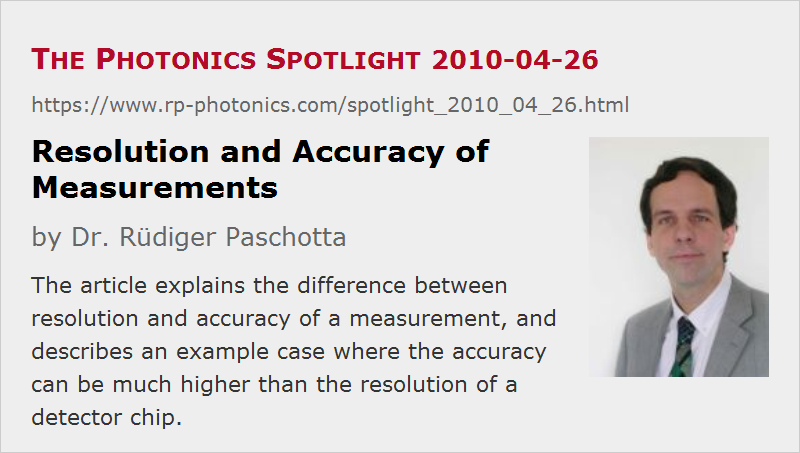Resolution and Accuracy of Measurements
Posted on 2010-04-26 as a part of the Photonics Spotlight (available as e-mail newsletter!)
Permanent link: https://www.rp-photonics.com/spotlight_2010_04_26.html
Author: Dr. Rüdiger Paschotta, RP Photonics Consulting GmbH
Abstract: The article explains the difference between resolution and accuracy of a measurement, and describes an example case where the accuracy can be much higher than the resolution of a detector chip.
Ref.: encyclopedia article on photodiodes

There is often a confusion between the terms resolution and accuracy of a measurement. Well, there is some relation between these terms. However, it is important to understand the difference:
- The resolution of a measurement is mostly relevant for digital readings: it tells in which steps the measurement result can change.
- The accuracy tells how well the result matches reality.
High Resolution, Low Accuracy
Obviously, a measurement could be totally inaccurate despite a high resolution. For example, the instrument's calibration may be wrong, or the reading may be influenced by strong noise influences, and a high resolution doesn't help against such types of errors.
As this is not totally obvious for many consumers, it is possible to sell cheap photo cameras with many megapixels (i.e., a high spatial resolution) which are not suitable for taking accurate pictures. In some cases, the quality of the optics is insufficient to make it worthwhile to use so many pixels. A large number of pixels can even be detrimental, particularly under conditions of low illumination, where detector noise becomes a problem.
Low Resolution, High Accuracy
Perhaps surprisingly, there are some cases where the accuracy of a result can be higher than the resolution of the apparatus used. As an example, consider a photodiode array which is used for the measurement of the position of some light point. We can consider the resolution to be the spacing of the detector elements. If the measurement method is simply to take the position where the highest recorded optical intensity is recorded, then the measurement error (without any noise or calibration errors) can be up to half the spacing of the detector elements. However, we may instead fit a curve (for example, a Gaussian) to the readings, and in that way determine the position with a much higher accuracy. This works well if the diameter of the light spot corresponds to a few detector spacings and the noise influences are weak. The accuracy can then be much better than the detector spacing. One may, however, refuse to identify the resolution with that detector spacing in such a case, because the calculate position results can indeed vary in much smaller steps. We actually have two types of resolution: the resolution of the intensity measurements and the resolution of numerical results calculated from these values.
This article is a posting of the Photonics Spotlight, authored by Dr. Rüdiger Paschotta. You may link to this page and cite it, because its location is permanent. See also the RP Photonics Encyclopedia.
Note that you can also receive the articles in the form of a newsletter or with an RSS feed.
Questions and Comments from Users
Here you can submit questions and comments. As far as they get accepted by the author, they will appear above this paragraph together with the author’s answer. The author will decide on acceptance based on certain criteria. Essentially, the issue must be of sufficiently broad interest.
Please do not enter personal data here; we would otherwise delete it soon. (See also our privacy declaration.) If you wish to receive personal feedback or consultancy from the author, please contact him e.g. via e-mail.
By submitting the information, you give your consent to the potential publication of your inputs on our website according to our rules. (If you later retract your consent, we will delete those inputs.) As your inputs are first reviewed by the author, they may be published with some delay.
 |



If you like this page, please share the link with your friends and colleagues, e.g. via social media:
These sharing buttons are implemented in a privacy-friendly way!